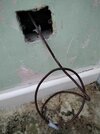Before you make any decisions with the wall, check there's a viable signal from the cable. Cut the existing plug off and fit a new one.
When you make up the new end then you'll also find out what quality of coax you're dealing with. Pre-2000s stuff has just a braid for shielding, though it will have a copper centre core. Later stuff installed because of the gradual shift to digital should have a two-layer shield comprised of braid over a foil wrap.
Digital TV signals are more prone to interference, hence the addition of a foil layer. There's a lot more interference (RFI) floating around now. You've got Wi-Fi and all the video comms gear using the 2.4GHz band, and there's mobile phone 4G/5G. Then there's the increased use of switch-mode power supplies in things such as phone charger plugs and the transformers for various bits of gear.
Christmas always sees an upswing on calls to sort out lost TV signals. It coincides with folk getting their Christmas tree lights out of storage. Those power supplies throw out some junk, and since they're often plugged in behind the TV cabinet (out of sight) then they're also close to old coax or even the newer stuff that's just a bit crap.
Recommending keeping the cable or going for a socket is always a bit of a toss up. Where you have good coax (copper foil, copper braid) then keeping the coax will deliver slightly more signal power to the TV. That might be important in a marginal signal area as a stop gap before you get the aerial proper sorted. In that case use a brush plate to finish off at the wall.
Where the coax is the old stuff, it'll still work, but can pick up more interference. As long as the TV signal isn't marginal, I'd recommend fitting a wall socket. The wall will provide some protection for the cable. The socket will then allow you to have a better shielded fly lead from the wall to the TV. A length of Webro WF100, Triax TX100 or Labgear CT100 will do the trick. There are all cables that use a copper metal foil, copper braid and copper centre core.


